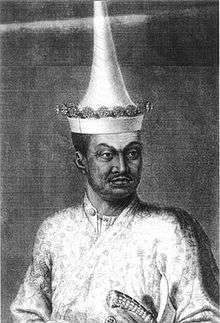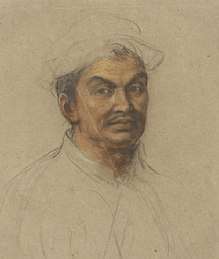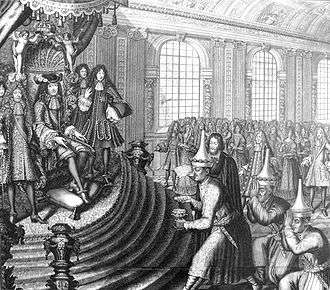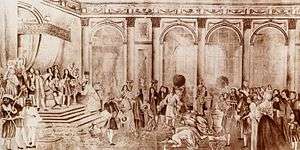Kosa Pan
Kosa Pan (Thai: ปาน; 1633 – 15 November 1699) was a Siamese diplomat and minister who led the second Siamese embassy to France sent by King Narai in 1686.[1]:262–263 He was preceded to France by the first Siamese embassy to France, which had been composed of two Siamese ambassadors and Father Bénigne Vachet, who had left Siam for France on January 5, 1684.[2] He was a nephew of King Ekathotsarot and a great grandfather of King Rama I, the founder of the Chakri Dynasty. His older brother, Lek (เหล็ก), also held the post of foreign minister before him.[3]
Kosa Pan | |
|---|---|
โกษาปาน | |
 French painting of Kosa Pan, in 1686 | |
| Ayutthaya Ambassador to France | |
| In office June 1686 – March 1687 Serving with Ok-luang Kanlaya Ratchamaitri Ok-khun Si Wisan Wacha | |
| Appointed by | Constantine Phaulkon |
| Monarch | Narai |
| Preceded by | Khun Pijaiwanit Khun Pijitmaitri |
| Succeeded by | Ok-khun Chamnan Ok-khun Wiset Puban Ok-muen Pipith Raja |
| Minister of Foreign Affairs and Trade of Ayutthaya | |
| In office 1688–1699 | |
| Monarch | Petracha |
| Preceded by | Okya Wang |
| Succeeded by | Okya Maha Amath |
| Personal details | |
| Born | 1633 Ayutthaya |
| Died | November 15, 1699 (aged 65–66) Ayutthaya |
| Nationality | Siamese |
| Children | Khunthong (son) |
| Mother | Chao Mae Dusit |
| Father | Mom Chao Jerdamphai |
| Relatives | Kosa Lek (brother) Thao Sri Chulalak (sister) |
| Occupation | diplomat, politician |
Early life
Lek was born to a Siamese woman Chao Mae Dusit in Ayutthaya Kingdom in 1633. Back then Chao was a wet nurse for Phetracha in 1632, and later on for Prince Narai, thus making Pan their foster brother.[4]
Names
Pan (Thai: ปาน; IPA: [paːn]) was his given name. As foreign minister, he was styled Chaophraya Kosathibodi (Thai: เจ้าพระยาโกษาธิบดี; IPA: [t͡ɕâːw.pʰrá.jaː koː.sǎː.tʰí.bɔː.diː]). He is colloquially called Kosa Pan (Thai: โกษาปาน; IPA: [koː.sǎː.paːn]).[5]
He is also known by his former style as a first-class diplomat: Ok-phra Wisut Sunthon (Thai: ออกพระวิสุทธสุนทร; IPA: [ʔɔ̀ːk.pʰrá wí.sùt sǔn.tʰɔːn]).[6] Contemporary French documents recorded his name as Ooc, Pravisoutsonthoon Raatchathoud (ออกพระวิสุทธสุนทร ราชทูต).
His success in diplomatic negotiations earned him the epithet golden-tongued diplomat (Thai: ราชทูตลิ้นทอง or นักการทูตลิ้นทอง).[7]
Embassy to France (1686)


To accompany the return of the 1685 French embassy to Siam of Chevalier de Chaumont and François-Timoléon de Choisy, Pan was selected by Constantine Phaulkon, the Prime Counsellor to King Narai, to lead an embassy to France. Pan set out for France in 1686 on two French ships with two other Siamese ambassadors, Ok-luang Kanlaya Ratchamaitri and Ok-khun Si Wisan Wacha,[8] and by the Jesuit Father Guy Tachard.[9]
The embassy was bringing a proposal for an eternal alliance between France and Siam. Pan's embassy was met with a rapturous reception and caused a sensation in the courts and society of Europe. The mission landed at Brest, France and journeyed to Versailles, constantly surrounded by crowds of curious onlookers.[10]:64–65 The embassy stayed in France from June 1686 to March 1687.
1688 Siamese revolution
Upon his return to Siam, Pan was pressured to become a supporter of Petracha's anti-French faction of dissatisfied nobles of whom resented the power that the French held in Siam. The following revolution toppled Narai and ousted the French forces, of which Pan was sent to negotiate with. He became henceforth Petracha's Minister of Foreign Affairs and Trade.[11][12]
Pan was met in Siam in 1690 by the German naturalist Engelbert Kaempfer, who described "pictures of the Royal family of France and European maps" hanging "in the hall of his house":[13]
"He is a more comely Person, and of better aspect, than I ever met amongst this black race of mankind... He is also quick of understanding and lively action, for which reasons he was a few years ago sent Ambassador to France, of which Country, its Government, Fortresses and the like, he would often entertain us in his discourses; and the hall of his House, where we had a private audience of him, was hung with the pictures of the Royal Family of France, and European Maps, the rest of his furniture being nothing but Dust and Cobwebs.
— Engelbert Kaempfer (1727/1987:38).[14]
In 1699, Pan and Petracha received a visit from the Jesuit Father Guy Tachard, but the meeting remained purely formal and led to nothing.[15]
Death
Pan was later accused of having affinity to the French and loyalty to his former King, Narai. He was disgraced, had his nose cut off by King Phetracha, and apparently committed suicide on 15 November 1699, according to the Dutch. His duties were taken over by Okya Maha Amath, one of the King's favorites. Nevertheless, he is claimed to be the direct ancestor of King Rama I, founder of the present ruling dynasty of Thailand.[16]
See also
- France-Thailand relations
Notes

- Rajanubhab, D., 2001, Our Wars With the Burmese, Bangkok: White Lotus Co. Ltd., ISBN 9747534584
- Asia in the Making of Europe, by Donald F. Lach, p. 253
- Smithies 2002, p. 100
- "History of Ayutthaya - Temples & Ruins - Wat Samana Kottharam". www.ayutthaya-history.com. Retrieved 2020-04-27.
- คำแก้ต่าง-ข้อแก้ตัวของโกษาปาน เรื่องปฏิวัติผลัดแผ่นดิน พ.ศ. ๒๒๓๑ [Explanation or excuse of Kosa Pan on 1688 coup] (in Thai). Historical Archives of the Archdiocese of Bangkok. 24 January 2013. Retrieved 15 July 2014.
- ออกพระวิสุทธสุนทร (โกษาปาน) [Ok Phra Wisut Sunthon (Kosa Pan)] (in Thai). Historical Archives of the Archdiocese of Bangkok. 4 October 2012. Retrieved 15 July 2014.
- Royal Institute of Thailand (2011). พจนานุกรมคำใหม่ เล่ม 3 ฉบับราชบัณฑิตยสถาน [Royal Institute Dictionary of New Words, Volume 3] (PDF) (in Thai). Bangkok: Royal Institute of Thailand. Archived from the original (pdf) on 18 July 2014. Retrieved 15 July 2014.
- Smithies 1999, p. 59
- Gunn, p. 188
- Chakrabongse, C., 1960, Lords of Life, London: Alvin Redman Limited
- Smithies 2002, p. 35
- Smithies 1999, p. 2
- Suarez, p. 30
- Quoted in Smithies 2002, p. 180
- Smithies 2002, p. 185
- Smithies 2002, p. 180
References
- Gunn, Geoffrey C. (2003) First Globalization: The Eurasian Exchange, 1500-1800 Rowman & Littlefield ISBN 0-7425-2662-3
- Smithies, Michael (1999), A Siamese embassy lost in Africa 1686, Silkworm Books, Bangkok, ISBN 974-7100-95-9
- Smithies, Michael (2002), Three military accounts of the 1688 "Revolution" in Siam, Itineria Asiatica, Orchid Press, Bangkok, ISBN 974-524-005-2
- Suarez, Thomas (1999) Early Mapping of Southeast Asia Tuttle Publishing ISBN 962-593-470-7
External links
- E-books
- Fine Arts Department of Thailand (1987). Phra Narai, roi de siam et Louis XIV, Musée de l'Orangerie, 13 juin – 13 juillet 1986 (pdf) (in Thai). Bangkok: Fine Arts Department of Thailand.
- Manich Jumsai (1988). The Story of King Narai and His Ambassador to France in 1686, Kosaparn (pdf) (in Thai). Thitima Phithakphraiwan, translator. Bangkok: Ministry of Education of Thailand. ISBN 9741006071.
- Manop Thanomsi (1990). Chaophraya Kosathibodi (Pan) (pdf) (in Thai). Bangkok: Ton-O.